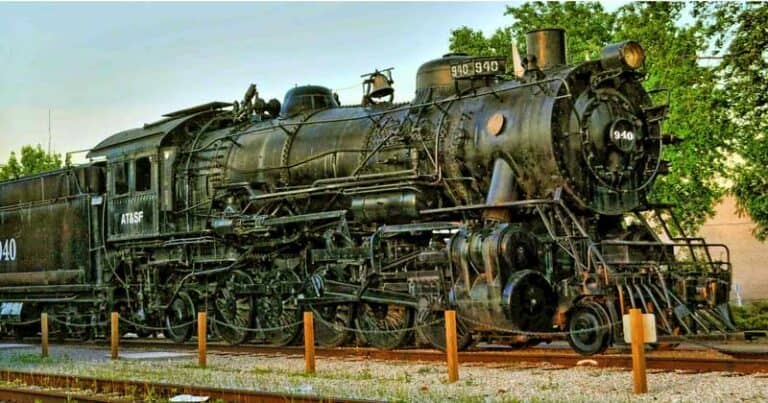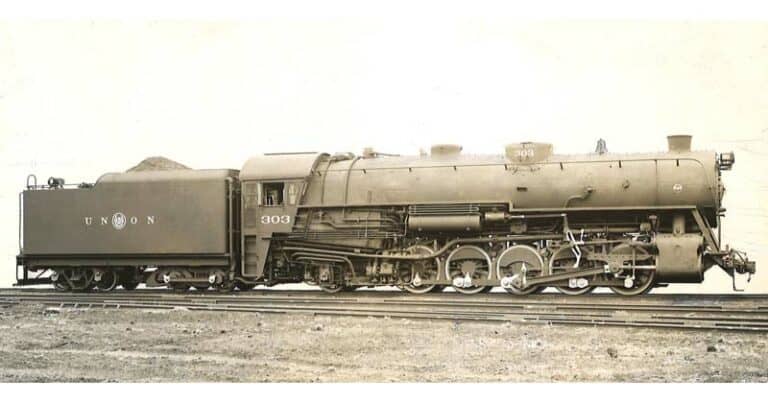2-8-8-2 Wheel Arrangement
In the early 20th century, large articulated steam locomotives were being built in large numbers as railroads conquered the mountains – and needed to move more and more freight over those mountains.
Just keep adding wheels!

For the first few decades American railroads were stuck with smaller locomotives ranging from “American” type locomotives, small 4-4-0 locomotives, up to 2-8-0 “Consolidation” types. Consolidations had proven that larger boilers and more wheels would in fact equal more pulling power and so the race was on to find the perfect combination of boiler size, number of wheels and wheel arrangement.
The 2-8-8-2 built on earlier articulated designs, such as the successful 2-6-6-2 “Chesapeake” type. This wheel arrangement was getting very close to what would turn out to be the most efficient maximum wheel arrangement, a 4-8-8-4 Big Boy. Even though it would seem that the Big Boy design would quickly follow the Chesapeake type, we are yet years away.
Southern Pacific turns it all around
The 2-8-8-2 wheel arrangement (Read how we classify steam locomotives.) ran on many railroads, starting with the Southern Pacific in 1909. This design was capable of hauling a huge amount of tonnage, although at very slow speeds. Typical speed for a 2-8-8-2 compound expansion Mallet was just 25 miles an hour.
Pretty quickly the Southern Pacific turned these locomotives around and they became the first of many “Cab Forwards”. This configuration made it safer for crews as the SP went through many tunnels in its trek over the Sierra Range. The SP was so impressed, it ordered more from Baldwin.
As the first railroad to order the 2-8-8-2 wheel arrangement, Southern Pacific by tradition had naming rights – but they didn’t name this “type”. And no other railroad did either. Many railroads rostered the 2-8-8-2 wheel arrangement: Great Northern, Denver & Rio Grande, Chesapeake & Ohio and the Pennsylvania Railroad to name just a few. But one railroad embraced the 2-8-8-2.
Reaching new milestones with the N&W
The Norfolk & Western found the locomotive very efficient for hauling coal. They believed in the design and over 40 years kept making improvements until they had the “Y6” class 2-8-8-2 locomotives, built at their own shops in Roanoke, Virginia. The Y6 Class is no doubt the pinnacle of the 2-8-8-2 design.
The “Y6” class would be phased out at the end of steam, some of the last steam locomotives to be retired in the nation, with the last one being retired in May 1960.
The first 2-8-8-2 locomotives arrived on the N&W in 1912 from Baldwin, and were “not ready for prime time”. These were designated Class Y1 and were scrapped in just a few years. The railroad still had to get long heavy trains over the mountains.
They knew the Mallet design could provide the power and the articulation could help with the tight curves built decades earlier for shorter engines. So, the N&W tried again with the 2-8-8-2 wheel arrangement, with each variant getting the next number in the Y Class.
The next set of 2-8-8-2 steam engines were designated, no surprise, as Class Y2. These were built by Baldwin with some also built by the N&W Shops at Roanoke. Management decided these were better and, making some changes based on their own experience, the next set of locomotives were designated Class Y3.
The N&W had finally dialed in the (almost) perfect “N&W Y Class”. Between the Y3 and Y3a classes, the N&W rostered 80 of these steaming giants. The N&W farmed these out to ALCo and Baldwin to build. And the big 2-8-8-2 locomotives kept coming. Class Y4 was built in 1927, Class Y5 in the early 1930s. The Y5 class was notable for being entirely produced at the company’s Roanoke Shops.
The N&W Y6 Class, The Pinnacle of Power
The Y5 introduced a new all-N&W design. It was beefier and more powerful. The Y6, Y6a and Y6b classes followed in that same design, with each version bigger, bolder and better than the previous. The Y6 Class and subclasses were the last of the 2-8-8-2 locomotives. All were built in the Roanoke Shops. All are revered by railfans as possibly the pinnacle of steam locomotive achievement.
All told the N&W rostered 232 2-8-8-2 type steam locomotives. Maybe the 2-8-8-2 wheel arrangement should have been called the “Norfolk”.
Survivors
Despite many railroads rostering these brutes, there are only two surviving 2-8-8-2s. It’s not a surprise that both are Norfolk & Western locomotives – having the most of this type in service means the luck of the draw would say a survivor was more likely to come from the N&W. That is not the only reason. The N&W and successor Norfolk Southern have been at the forefront of steam locomotives preservation, and both of these locomotives were saved and then donated by those railroads.
The first surviving 2-8-8-2 is N&W #2156, a N&W Class Y6a which is on static display at the National Museum of Transportation in St. Louis, Missouri. It was built in 1946 for hauling manifest freight and coal trains over the mountains on the railroad’s Pocahontas, Shenandoah and Radford Divisions.

Read more about N&W Y6a #2156.
The other survivor is N&W #2050, which is on static display far afield from its original working home in the Virginia and West Virginia coal fields. #2050 is at the Illinois Railway Museum in Union, Illinois. This is a Class Y3a used in “drag” service, dragging long trains of coal and manifest freight up and over the mountains.

Railfan and model railroader. Writer and consumer of railroad news and information.







